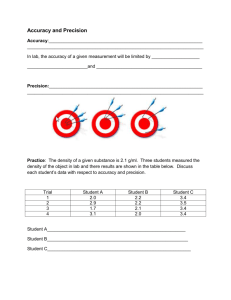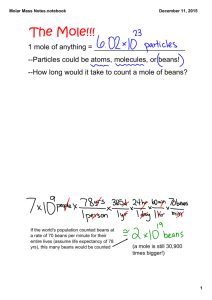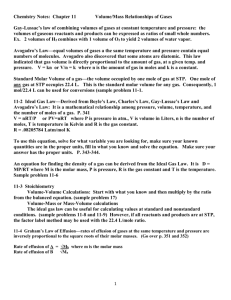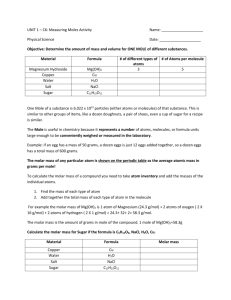Word - Chemmybear.com
advertisement
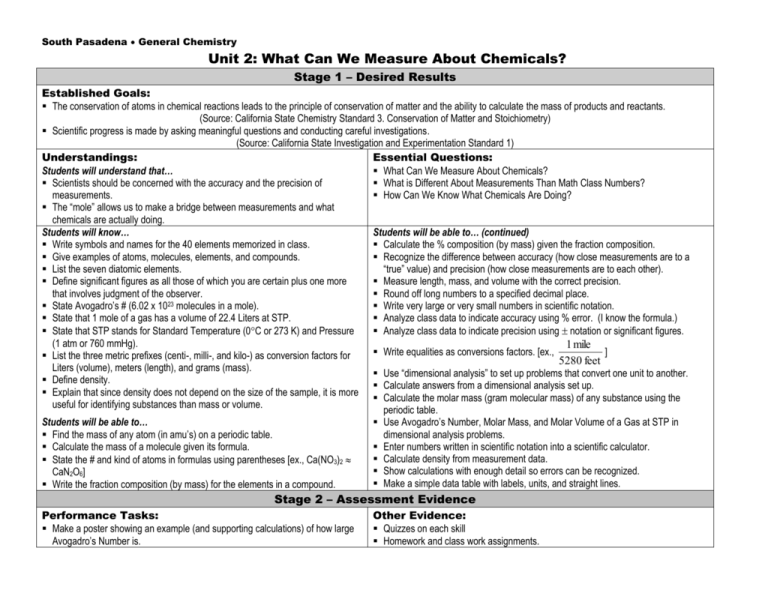
South Pasadena General Chemistry Unit 2: What Can We Measure About Chemicals? Stage 1 – Desired Results Established Goals: The conservation of atoms in chemical reactions leads to the principle of conservation of matter and the ability to calculate the mass of products and reactants. (Source: California State Chemistry Standard 3. Conservation of Matter and Stoichiometry) Scientific progress is made by asking meaningful questions and conducting careful investigations. (Source: California State Investigation and Experimentation Standard 1) Understandings: Essential Questions: Students will understand that… What Can We Measure About Chemicals? Scientists should be concerned with the accuracy and the precision of What is Different About Measurements Than Math Class Numbers? measurements. How Can We Know What Chemicals Are Doing? The “mole” allows us to make a bridge between measurements and what chemicals are actually doing. Students will know… Students will be able to… (continued) Write symbols and names for the 40 elements memorized in class. Calculate the % composition (by mass) given the fraction composition. Give examples of atoms, molecules, elements, and compounds. Recognize the difference between accuracy (how close measurements are to a List the seven diatomic elements. “true” value) and precision (how close measurements are to each other). Define significant figures as all those of which you are certain plus one more Measure length, mass, and volume with the correct precision. that involves judgment of the observer. Round off long numbers to a specified decimal place. State Avogadro’s # (6.02 x 1023 molecules in a mole). Write very large or very small numbers in scientific notation. State that 1 mole of a gas has a volume of 22.4 Liters at STP. Analyze class data to indicate accuracy using % error. (I know the formula.) State that STP stands for Standard Temperature (0C or 273 K) and Pressure Analyze class data to indicate precision using notation or significant figures. (1 atm or 760 mmHg). 1 mile Write equalities as conversions factors. [ex., ] List the three metric prefixes (centi-, milli-, and kilo-) as conversion factors for 5280 feet Liters (volume), meters (length), and grams (mass). Use “dimensional analysis” to set up problems that convert one unit to another. Define density. Calculate answers from a dimensional analysis set up. Explain that since density does not depend on the size of the sample, it is more Calculate the molar mass (gram molecular mass) of any substance using the useful for identifying substances than mass or volume. periodic table. Students will be able to… Use Avogadro’s Number, Molar Mass, and Molar Volume of a Gas at STP in Find the mass of any atom (in amu’s) on a periodic table. dimensional analysis problems. Calculate the mass of a molecule given its formula. Enter numbers written in scientific notation into a scientific calculator. Calculate density from measurement data. State the # and kind of atoms in formulas using parentheses [ex., Ca(NO3)2 Show calculations with enough detail so errors can be recognized. CaN2O6] Make a simple data table with labels, units, and straight lines. Write the fraction composition (by mass) for the elements in a compound. Stage 2 – Assessment Evidence Performance Tasks: Make a poster showing an example (and supporting calculations) of how large Avogadro’s Number is. Other Evidence: Quizzes on each skill Homework and class work assignments. CALIFORNIA STATE STANDARDS IN UNIT 2 Conservation of Matter and Stoichiometry 3. The conservation of atoms in chemical reactions leads to the principle of conservation of matter and the ability to calculate the mass of products and reactants. As a basis for understanding this concept, students know: how to describe chemical reactions by writing balanced equations. the quantity one mole is defined so that one mole of carbon 12 atoms has a mass of exactly 12 grams. one mole equals 6.02x1023 particles (atoms or molecules). how to determine molar mass of a molecule from its chemical formula and a table of atomic masses, and how to convert the mass of a molecular substance to moles, number of particles or volume of gas at standard temperature and pressure. how to calculate the masses of reactants and products in a chemical reaction from the mass of one of the reactants or products, and the relevant atomic masses. * how to calculate percent yield in a chemical reaction. * how to identify reactions that involve oxidation and reduction and how to balance oxidation-reduction reactions. Investigation and Experimentation 1. Scientific progress is made by asking meaningful questions and conducting careful investigations. As a basis for understanding this concept, and to address the content the other four strands, students should develop their own questions and perform investigations. Students will: select and use appropriate tools and technology (such as computer-linked probes, spread sheets, and graphing calculators) to perform tests, collect data, analyze relationships, and display data. identify and communicate sources of unavoidable experimental error. identify possible reasons for inconsistent results, such as sources of error or uncontrolled conditions. formulate explanations using logic and evidence. solve scientific problems using quadratic equations, and simple trigonometric, exponential, and logarithmic functions. distinguish between hypothesis and theory as science terms. recognize the use and limitations of models and theories as scientific representations of reality. recognize the issues of statistical variability and the need for controlled tests. recognize the cumulative nature of scientific evidence. analyze situations and solve problems that require combining and applying concepts from more than one area of science. investigate a science-based societal issue by researching the literature, analyzing data, and communicating the findings. Examples include irradiation of food, cloning of animals by somatic cell nuclear transfer, choice of energy sources, and land and water use decisions in California. know that when an observation does not agree with an accepted scientific theory, sometimes the observation is mistaken or fraudulent (e.g., Piltdown Man fossil or unidentified flying objects), and sometimes the theory is wrong (e.g., Ptolemaic model of the movement of the sun, moon and planets).
